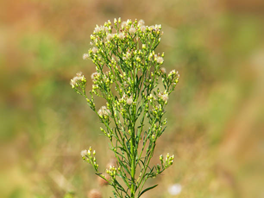

30th July 2022 (7 Topics)
Context
A recent study indicates that the plant species considered as invasive in non-native regions, use characteristics to survive and flourish that are different from the ones in their native regions.
About
Key Findings of the study:
- A study of the Canadian horseweed species revealed the changing behaviour of plant species in non-native regions, helping them to become successful invaders.
- Conyza canadensis, commonly known as Canadian horseweed (Asteraceae) across four Mediterranean populations of California and Jordan, inter-mountain western United States and central China has been studied.
- Soil microbial activity plays an important role in making invasive species flourish in non-native regions.
- The microbial activity in the roots of the plant in native regions was less and the species showed more parasitic properties.
- In India, the EU and Asia, the micro-fungal benefits were mutual.
- The plants took carbon from the soil, but released nutrients such as phosphorous, nitrogen and others in return.
- The high amount of nutrients offered attracted microbes and fungi growth.
- The findings show that the benefits are mutual in such a case and the plant evolved towards enhanced mutualism as it interacted with the microbes.
- The study showed that such changing relations at a bio geographical scale between the plant and soil biota contributed towards the disproportionate abundance and success of the species as an invader in non-native regions.

About invasive species:
- An invasive species is an organism that is not indigenous, or native, to a particular area.
- Pathways: An invasive species can be introduced to a new area via the ballast water of oceangoing ships, intentional and accidental releases of aquaculture species, aquarium specimens or bait, and other means.
- Not all non-native species are invasive.
- For example, most of the food crops grown in the United States, including popular varieties of wheat, tomatoes, and rice, are not native to the region.
- Features: To be invasive, a species must
- It must adapt to the new area easily.
- It must reproduce quickly.
- It must harm property, the economy, or the native plants and animals of the region.
- Threats
- Extinction of native ecosystem: Invasive species are capable of causing extinctions of native plants and animals, reducing biodiversity, competing with native organisms for limited resources, and altering habitats.
- This can result in huge economic impacts and fundamental disruptions of coastal and Great Lakes ecosystems.
- Threat to resources: Invasive species can harm both the natural resources in an ecosystem as well as threaten human use of these resources.
- Threat to native wildlife: Invasive species are among the leading threats to native wildlife.
- Approximately 42 percent of threatened or endangered species are at risk due to invasive species.
List of invasive flora and fauna in India
|
Name |
State / Region |
Native to |
|
African apple snail |
Andaman and Nicobar |
|
|
Papaya Mealy Bug |
Assam |
Mexico and Central America, |
|
Cotton Mealy Bug |
Deccan |
North America |
|
Amazon sailfin catfish |
West Bengal |
|
|
Black Wattle |
Western Ghats |
South East Australia |
|
Water Hyacinth |
It is found throughout India |
Tropical America |
|
Black Mimosa |
Himalaya, Western Ghats |
Tropical North America |
|
Parthenium/ Congress grass, Parthenium |
It is found throughout India |
Tropical North America |
|
Cannibal Snail / Rosy wolf snail |
– |
Native to the southeastern United States. |
|
Indian Bullfrog |
Andaman and Nicobar |
Afghanistan, Bangladesh, India, Myanmar, Nepal, Pakistan |
|
Lantana camara |
In the Bandipur National Park, Karnataka |
South America |


